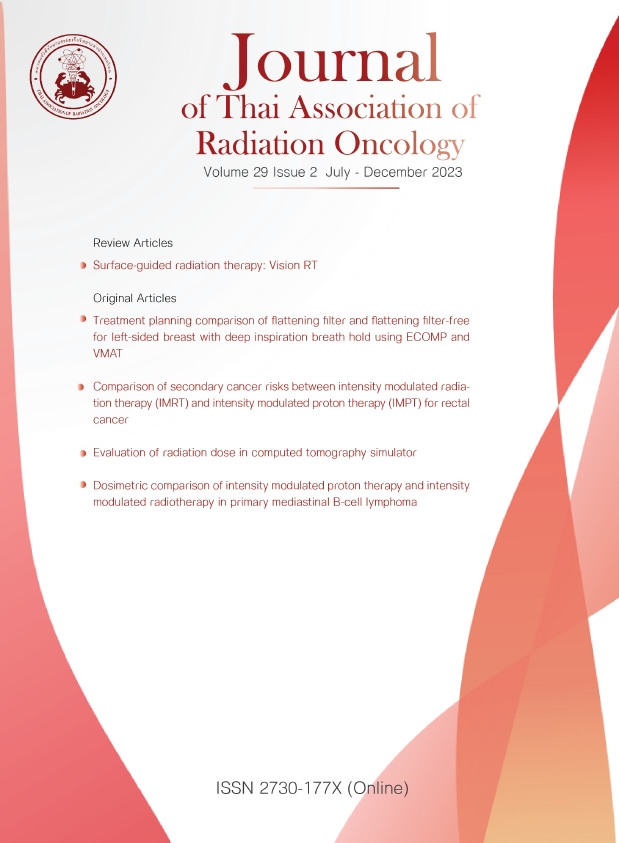Comparison of secondary cancer risks between intensity modulated radiation therapy (IMRT) and intensity modulated proton therapy (IMPT) for rectal cancer
Keywords:
Rectal cancer, secondary cancer risk, IMRT, IMPTAbstract
Backgrounds: Radiation therapy plays an important role in rectal cancer treatment. However, according to atomic bomb survivor studies, radiation is a risk factor for solid cancer incidence in any tissues. Therefore, radiation therapy is relevant for an increased risk for developing secondary cancer in treated patients.
Objective: To evaluate and compare secondary cancer risks between intensity modulated radiation therapy (IMRT) and intensity modulated proton therapy (IMPT) for rectal cancer in terms of organ equivalent dose (OED) and organ-specific excess absolute risk (EARorg).
Materials and methods: A male adult computational phantom with an average body size of a 68-year-old Thai male was used for IMRT and IMPT treatment planning. For IMRT, 12 fields of 6 MV flattening filter free (FFF) photon beams were used for treatment planning using the Ethos treatment planning system (TPS) (Varian Medical System, Palo Alto, California, USA), while 2-, 3-, and 5-field IMPT plans were calculated using matRad TPS. Dose distributions and OEDs were evaluated for organs at risk (OARs). The calculation of secondary cancer risk was done in terms of EARorg using a mechanistic model for radiation-induced carcinoma and sarcoma.
Results: IMPT delivered lower doses to the OARs than IMRT. The EAR in 10,000 persons per year (PY) for the IMPT plans ranged from 0.60 to 0.71 for the bladder, 0.07 to 0.08 for the bowel and 13.59 to 14.35 for the colon, while the EAR for the IMRT plan was 0.33 for the bladder, 0.96 for the bowel, and 21.90 for the colon. The colon had the highest risk of secondary cancer incidence, although the mean organ dose was much lower than those in other organs. Our result indicated that IMPT decreased secondary cancer risks in most organs compared to IMRT, except for the bladder, where low dose exposure by IMPT led to unfavorably high risk. Moreover, the risk of bone and soft tissue sarcomas after IMRT and IMPT were relatively small.
Conclusion: Based on the mechanistic risk model, the estimated secondary cancer risk after IMPT was generally lower than that after IMRT. The 2-field IMPT plan had the lowest risk among all IMPT plans investigated.
References
Rawla P, Sunkara T, Barsouk A. Epidemiology of colorectal cancer: incidence, mortality, survival, and risk factors. Prz Gastroenterol. 2019;14:89–103.
Lohsiriwat V, Chaisomboon N, Pattana-Arun J. Current colorectal cancer in Thailand. Ann Coloproctol. 2020;36:78–82.
Lidder PG, Hosie KB. Rectal Cancer: The role of radiotherapy. Dig Surg. 2005;22:41–9.
Kry SF, Bednarz B, Howell RM, Dauer L, Followill D, Klein E, et al. AAPM TG 158: Measurement and calculation of doses outside the treated volume from external-beam radiation therapy. Med Phys. 2017;44:e391–429.
Hall EJ. Intensity-modulated radiation therapy, protons, and the risk of second cancers. Int J Radiat Oncol Biol Phys. 2006;65:1–7.
Fok M, Toh S, Easow J, Fowler H, Clifford R, Parsons J, et al. Proton beam therapy in rectal cancer: A systematic review and meta-analysis. Surg Oncol. 2021;38:101638.
Schneider U. Modeling the risk of secondary malignancies after radiotherapy. Genes. 2011;2:1033–49.
Wheldon EG, Lindsay KA, Wheldon TE. The dose–response relationship for cancer incidence in a two-stage radiation carcinogenesis model incorporating cellular repopulation. Int J Radiat Oncol Biol. 2000;76:699–710.
Lindsay KA, Wheldon EG, Deehan C, Wheldon TE. Radiation carcinogenesis modelling for risk of treatment-related second tumours following radiotherapy. Br J Radiol. 2001;74:529–36.
Dasu A, Toma-Dasu I. Models for the risk of secondary cancers from radiation therapy. Phys Med. 2017;42:232–8.
Sachs RK, Brenner DJ. Solid tumor risks after high doses of ionizing radiation. Proc Natl Acad Sci USA. 2005;102:13040–5.
Schneider U. Mechanistic model of radiation-induced cancer after fractionated radiotherapy using the linear-quadratic formula: Cancer risk for fractionated radiotherapy. Med Phys. 2009;36:1138–43.
Schneider U, Sumila M, Robotka J. Site-specific dose-response relationships for cancer induction from the combined Japanese A-bomb and Hodgkin cohorts for doses relevant to radiotherapy. Theor Biol Med Model. 2011;8:27.
Schneider U, Zwahlen D, Ross D, Kaser-Hotz B. Estimation of radiation-induced cancer from three-dimensional dose distributions: Concept of organ equivalent dose. Int J Radiat Oncol Biol Phys. 2005;61:1510–5.
Lee C, Lodwick D, Hurtado J, Pafundi D, Williams JL, Bolch WE. The UF family of reference hybrid phantoms for computational radiation dosimetry. Phys Med Biol. 2010;55:339–63.
Geyer AM, O’Reilly S, Lee C, Long DJ, Bolch WE. The UF/NCI family of hybrid computational phantoms representing the current US population of male and female children, adolescents, and adults—application to CT dosimetry. Phys Med Biol. 2014;59:5225–42.
Bentzen SM, Constine LS, Deasy JO, Eisbruch A, Jackson A, Marks LB, et al. Quantitative Analyses of Normal Tissue Effects in the Clinic (QUANTEC): An introduction to the scientific issues. Int J Radiat Oncol Biol Phys. 2010;76:S3–9.
Klopp AH, Moughan J, Portelance L, Miller BE,
Salehpour MR, D’Souza D, et al. Hematologic toxicity on RTOG 0418: A phase II study of post-operative IMRT for gynecologic cancer. Int J Radiat Oncol Biol Phys. 2010;78:S121.
Klopp AH, Yeung AR, Deshmukh S, Gil KM, Wenzel L, Westin SN, et al. Patient-reported toxicity during pelvic intensity-modulated radiation therapy: NRG oncology–RTOG 1203. J Clin Oncol. 2018;36:2538–44.
Hong TS, Moughan J, Garofalo MC, Bendell J, Berger AC, Oldenburg NBE, et al. NRG oncology radiation therapy oncology group 0822: A phase 2 study of preoperative chemoradiation therapy using intensity modulated radiation therapy in combination with capecitabine and oxaliplatin for patients with locally advanced rectal cancer. Int J Radiat Oncol Biol Phys. 2015;93:29–36.
Cheng JY, Huang EY, Hsu SN, Wang CJ. Simultaneous integrated boost (SIB) of the parametrium and cervix in radiotherapy for uterine cervical carcinoma: a dosimetric study using a new alternative approach. Br J Radiol. 2016;89:20160526.
Wieser HP, Cisternas E, Wahl N, Ulrich S, Stadler A, Mescher H, et al. Development of the open-source dose calculation and optimization toolkit matRad. Med Phys. 2017;44:2556–68.
Parzen JS, Zheng W, Li X, Ding X, Kabolizadeh P. Optimization of field design in the treatment of rectal cancer with intensity modulated proton beam radiation therapy: How many fields are needed to account for rectal distension uncertainty? Adv Radiat Oncol. 2021;6:100749.
Preston DL, Ron E, Tokuoka S, Funamoto S, Nishi N, Soda M, et al. Solid cancer incidence in atomic bomb survivors: 1958–1998. Radiat Res. 2007;168:1–64.
Diallo I, Haddy N, Adjadj E, Samand A, Quiniou E, Chavaudra J, et al. Frequency distribution of second solid cancer locations in relation to the irradiated volume among 115 patients treated for childhood cancer. Int J Radiat Oncol Biol Phys. 2009;74:876–83.
Zwahlen DR, Bischoff LI, Gruber G, Sumila M, Schneider U. Estimation of second cancer risk after radiotherapy for rectal cancer: comparison of 3D conformal radiotherapy and volumetric modulated arc therapy using different high dose fractionation schemes. Radiat Oncol. 2016;11:149.
Shuryak I, Sachs RK, Brenner DJ. Cancer risks after radiation exposure in middle Age. J Natl Cancer Inst. 2010;102:1628–36.
Shuryak I, Hahnfeldt P, Hlatky L, Sachs RK, Brenner DJ. A new view of radiation-induced cancer: integrating short- and long-term processes. Part I: Approach. Radiat Environ Biophys. 2009;48:263–74.
Shuryak I, Hahnfeldt P, Hlatky L, Sachs RK, Brenner DJ. A new view of radiation-induced cancer: integrating short- and long-term processes. Part II: second cancer risk estimation. Radiat Environ Biophys. 2009;48:275–86.
Richardson DB, Wing S. Greater sensitivity to ionizing radiation at older age: follow-up of workers at Oak Ridge national laboratory through 1990. Int J Epidemiol. 1999;28:428–36.
Schneider U, Lomax A, Pemler P, Besserer J, Ross D, Lombriser N, et al. The impact of IMRT and proton radiotherapy on secondary cancer incidence. Strahlenther Onkol. 2006;182:647–52.
Schneider U, Hälg R. The impact of neutrons in clinical proton therapy. Front Oncol. 2015;5:235.
Joosten A, Matzinger O, Jeanneret-Sozzi W, Bochud F, Moeckli R. Evaluation of organ-specific peripheral doses after 2-dimensional, 3-dimensional and hybrid intensity modulated radiation therapy for breast cancer based on Monte Carlo and convolution/superposition algorithms: Implications for secondary cancer risk assessment. Radiother Oncol. 2013;106:33–41.
Downloads
Published
How to Cite
Issue
Section
License
Copyright (c) 2023 Thai Association of Radiation Oncology

This work is licensed under a Creative Commons Attribution-NonCommercial-NoDerivatives 4.0 International License.
บทความที่ได้รับการตีพิมพ์เป็นลิขสิทธิ์ของวารสารมะเร็งวิวัฒน์ ข้อความที่ปรากฏในบทความแต่ละเรื่องในวารสารวิชาการเล่มนี้เป็นความคิดเห็นส่วนตัวของผู้เขียนแต่ละท่านไม่เกี่ยวข้องกับ และบุคคลากรท่านอื่น ๆ ใน สมาคมฯ แต่อย่างใด ความรับผิดชอบองค์ประกอบทั้งหมดของบทความแต่ละเรื่องเป็นของผู้เขียนแต่ละท่าน หากมีความผิดพลาดใดๆ ผู้เขียนแต่ละท่านจะรับผิดชอบบทความของตนเองแต่ผู้เดียว




